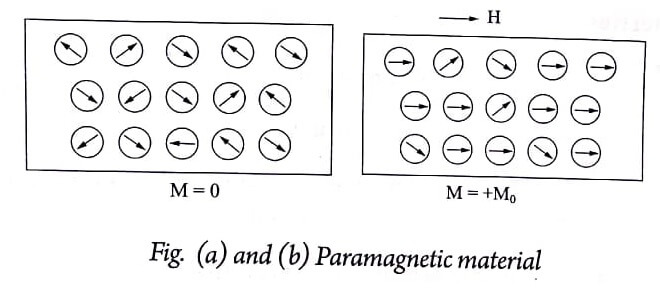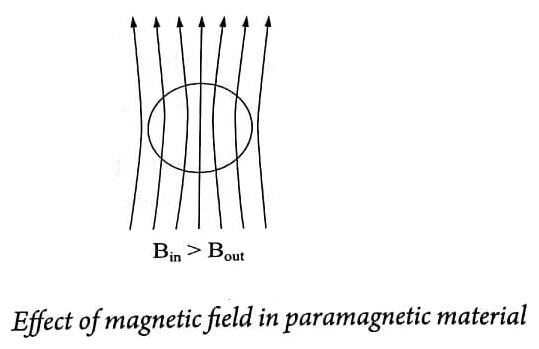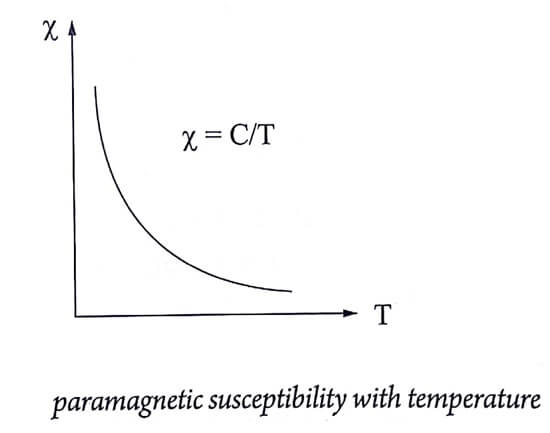Definition : In certain materials, each atom or molecule possesses a net permanent magnetic moment (due to the orbital and spin magnetic moments) even in the absence of an external magnetic field.
or
The substances which when placed in a magnetic field are weakly magnetised in the direction of the applied field, are called paramagnetic substances.
Examples: Aluminium, CuSO4, MnSO4, Platinum, Chromium, Oxygen, NiSO4, etc.
Explanation: The magnetic moments are randomly oriented in the absence of an external magnetic field. This makes the magnetisation of the material nearly zero, i.e., a little magnetization is present within the material.

- (a) Each atom possesses a permanent magnetic moment. When H=0, all the magnetic moments are randomly oriented; so M≠0.
- (b) When a magnetic field H0 is applied, the magnetic moments tend to orient themselves in the direction of the field, resulting in positive susceptibility.
- But, when an external magnetic field is applied, the magnetic dipoles tend to align themselves in the direction of the magnetic field and the material becomes magnetized. (Fig).
- This effect is known as Paramagnetism.
- But the temperature opposes this alignment. Therefore, when there is an increase in temperature, the increase in thermal agitation tends to randomize the dipole direction thus leading to a decrease in magnetization.
- This implies that the paramagnetic susceptibility decreases with increase in temperature. It is observed that the paramagnetic susceptibility varies inversely with temperature.
![]()
This is known as the Curie Law of Paramagnetism and ‘C‘ is a constant called Curie constant.
Properties
- It possess permanent dipole moment.
- It is feebly attracted by a magnet.
- The magnetic lines of force pass through the material.

4. Since magnetic lines of force pass through the material, they posses permanent dipole moment which makes permeability greater than one.
5. Magnetic susceptibility is positive and it greatly depends on the temperature.
It is given by
![]()
Where, C = curie constant, T = absolute temperature, θ = curie temperature

6. Magnetic susceptibility is independent of applied magnetic field.
7. When the temperature is less than curie temperature, paramagnetic material becomes diamagnetic material.
8. If a paramagnetic substance is placed in a nonuniform magnetic field, it is attracted towards the stronger magnetic field.
Can you state any four properties of a paramagnetic material?
Here are four key properties of paramagnetic materials:
- Weakly Attracted to Magnetic Fields – Paramagnetic materials exhibit a weak attraction when placed in an external magnetic field.
- Alignment of Magnetic Dipoles – Their atomic dipoles align parallel to the applied field but lose alignment once the field is removed.
- Positive Magnetic Susceptibility – They have a small, positive magnetic susceptibility, meaning they enhance the external magnetic field slightly.
- Temperature Dependency – Their magnetism decreases with increasing temperature, following Curie’s Law.
Examples include aluminum, platinum, and oxygen.
How does Paramagnetism work?
Paramagnetism occurs when materials have unpaired electrons, causing them to align with an external magnetic field, resulting in a weak attraction.
| Read More Topics |
| Classification of magnetic materials |
| Definition and properties for diamagnetism |
| Origin of magnetic moments |





